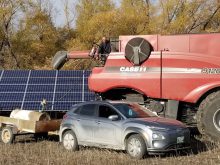In every issue of Grainews you’ll see at least two or three articles about the benefits of long-term crop rotations. Or, if there aren’t whole articles, there are always a few comments from experts about using four- or even eight-year rotations instead of something like canola, snow, canola, snow. We’ve all heard about the benefits: slowing the spread of disease, lowering levels of disease in the soil and so on.
You’ll also find an article or two about rotating herbicides. There was a day when smokers didn’t know cigarettes caused lung cancer. There was a day when farmers didn’t know that using the same herbicide year after year would lead to the rise (and potential future world domination) of herbicide-tolerant kochia. Now we know, and we’re doing our best to keep careful records so we can change up the herbicides we use on each patch of land from year to year.
Read Also

Health hazards are often overlooked risks on the farm
While quite different from the dangers posed by farm machinery, hazards such as loud noise or sun exposure require the same proactive attention, the Canadian Agricultural Safety Association says.
We’ve even run one or two pieces in Grainews about changing up varieties of canola seed to help stave off blackleg (different canola varieties are resistant to different blackleg strains).
Tracking all this information is a bit of a chore, and working out a crop and chemical plan that takes historical data, soil tests, input prices, weather forecasts and price projections into account is like putting together a huge jigsaw puzzle. In 3D.
Agronomically, the only way to make the pieces fit into this 3D puzzle is to have a long-term plan and stick pretty closely to it.
So what do you do if a piece falls out? It’s hard to find another piece exactly the right shape to fill that gap. But that’s what can happen when a farmer needs to replace one piece of rental land with another.
Short-term rentals
FCC has estimated that 40 per cent of Canadian farmland is rented. Most ag landlords have the same long-term goals as farmers: a long-term profit, healthy soil and an asset that appreciates over time.
Most landowners understand that farmers can’t just maximize profit on every field every year. For examples, some years we have to plant lower-profit wheat on some fields, instead of throwing the dice and planting lentils, to keep disease under control.
Many landowners are still close to the community, and the land. Maybe they live just down the road, or maybe they’ve moved to town but still spend mornings in the coffee shop, listening to farmers talk about the economic costs of clubroot.
But not all landowners fall into this category. Some owners inherited land, but maybe their grandmother moved to the city, and they’re two generations away from the combine cab now. Do these landowners understand why their renters can’t always make the highest profit on their particular quarter section of land? Far-flung landowners have a very small personal stake in stewardship projects like curbing herbicide-tolerant weeds — are they willing to forego a short-term profit so renters can spend a little more on a multi-action tank mix?
The Canada Pension Plan Investment Board owns 113,000 acres of Saskatchewan farmland. When your aunt in Calgary picks up her CPP cheque, do you think she takes time to wonder how many years in a row CPP’s renters are spraying glyphosate on her share of that investment?
AgCapita owns over 90,000 acres of Saskatchewan farmland, scattered around the province. I’m sure their land managers care about long-term soil health, but when investors put their money into AgCapita’s fund, do you think most of them ask to see records proving that all AgCapita’s renters are maintaining a four-year crop rotation?
Think of your investment portfolio. We have a handful of shares in Apple. But I’ve never checked the fine print on the Annual Report to make sure Apple is spending a fair amount of its profits to combat Internet viruses. That sort of expenditure is good for everyone the industry in the long term, like slowing herbicide resistance, but actions like that don’t do a lot for annual share prices.
The problem isn’t that landowners and farmers have different long-term needs — everybody wants an asset that can pay out a profit for decades to come, if not longer. The problem is that it’s easier for farmers to see how short-term sacrifices help build long-term value. We know we have to plant some wheat, even though it’s not penciling in that well. We can explain that to Uncle Henry over pie when he owns the land we’re renting. It takes more time to explain agronomy to an investor in downtown Montreal, and it’s a lot harder to meet up with her to discuss root rot.
Long-term agreements, with data
The only way farmers are going to make rented land fit into the 3D puzzle of good agronomic rotations is to be absolutely sure about how long we’ll have each puzzle piece, and the precise shape of that puzzle piece.
If we’re going to make sure our goals are aligned and the soil is healthy, we need long-term rental agreements, and, perhaps more important, crop and chemical records when we’re renting land that’s “new” to us.
Long-term agreements are the key to good agronomy. Without a long-term agreement, when profit margins are low, farmers can’t take on the financial costs of maintaining healthy soil that they don’t own.
Who can afford to spend the extra money to build up a supply of phosphorus if they’re not absolutely sure they’ll be renting that same land for the next two years? If you’re pretty convinced you won’t have a chance to rent that quarter section in 2018, will you be tempted to sneak in a second-in-a-row canola crop instead of planting oats?
We also need good information. Without data that outlines what’s happened for the past few years, farmers can’t organize agronomically-sound rotations and chemical plans on rented land. Without good data, how can you be sure how often glyphosate’s been sprayed on that land? How can you be sure you’re not helping to create herbicide-tolerant weeds to share with the whole community?
Ideally, one day all renters and landowners will all insist on long-term agreements and shared historical data. But both sides are going to have to start demanding it to make that happen.














